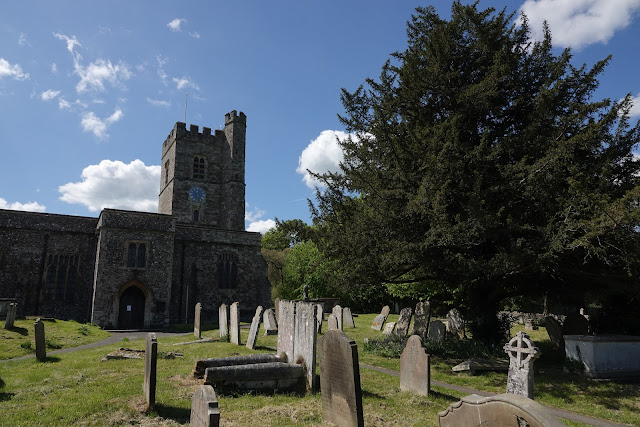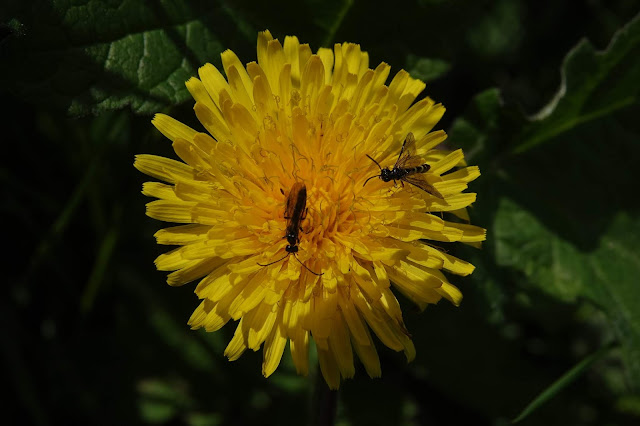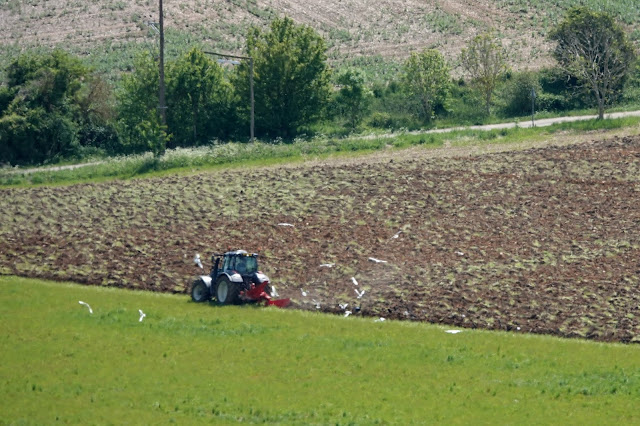Needing to go to the Post Office again dictated the
direction of travel this morning as I set out on a chilly blue sky
morning. I could hear the ‘shu shu’ of
baby Starlings but as yet they are not out and about but with at least 35 pairs
counted using my road at the moment the greens will soon have a covering of begging
brown babies. I stopped to take some
pics of the last remaining Dandelion clocks, Daisies and Buttercups as I could
hear the dreaded council grass butchers on their way up the hill.
 |
| Dandelion |
 |
| Daisy |
 |
| Buttercup |
I made my way through the tunnel and into the Ranscombe –
Cobham Woods. There was not one person
around and I was surrounded by singing Blackcaps, drumming Great Spotted
Woodpeckers and dappled light falling through the still young
leaves of Chestnut and Oak.
 |
| Meadow Cranesbill in waiting |
I had sub-consciously removed the drone of the once again busy
A2 and it was just me and the trees. I said hello to some of my favourites as I
headed up amongst them before my first bubbling Garden Warbler of the day stopped
me for a while. It seemed like he made sure not to start up if a Blackcap was
already going for it.
 |
| Garden Warbler |
A Blackcap may well be able to throw bits of Song
Thrush, Nightingale and Lesser Whitethroat into its song but it never sounds
like the almost uncontrollable outpouring of a Garden Warbler. I think only
Eastern Orphean Warbler gives it a run for its money as Sylvia top vocalist.
I turned north at the start of the Cobham Estate Highland Cattle enclosure as I wanted to enter it along the golf course edge to check
for new songsters as I had not been that way for some time. Another Garden Warbler sang and the Fallow
Deer had left some evidence of their presence on the path.
 |
| Fallow
Deer- spending a pound not a penny |
A sunny Bramble and Nettle patch held a couple of Speckled
Woods and a few flies that posed in their desire to warm up a little.
 |
| Speckled
Wood |
 |
| Speckled
Wood |
 |
| Eristalis pertinax |
 |
| Anthomyiidae sp |
 |
| Anthomyiidae sp |
I was greeted by another drumming Great Spot as I entered
the enclosure and a Song Thrush was belting out from the extensive Ash Grove
just beyond the fenceline. Bar an odd Oak it just seemed to be this species and
I did not notice it last time I walked here.
 |
| The enclosure |
 |
| The Ash Grove |
 |
| Highland Cattle hair rub on stump with lots of what looked like fly eggs attached |
Blackcaps and my third new Garden Warbler were found and a
Treecreeper sang just before I emerged back onto Cobham Golf Course which was looking
beautifully tended but there was still absolutely no chance of my getting hit
by a flying ball.
Once at Cobham I retraced my steps from last week down past
the cricket pitch and into Jeskyns CP with the intent of covering what I failed
to get to before. The Fox family were firmly out of sight today.
 |
| Ground Elder |
 |
| Can't remember what this bridge is called? |
It was somewhat busy
with dog walkers and buggies but I avoided the crowd feeding the sheep (or is
that sheep feeding the sheep?) and made my way towards the western edge where I
was pleased to discover a fine male Yellowhammer foraging for insects in the young
apple trees there. Another gap filled on the Lockdown List and worrying that
this is the only one I have encountered.
 |
| Yellowhammer |
 |
| Yellowhammer |
 |
| There was a brood of Coots on the pond |
A few hundred yards away it became Bunting Double Bubble
with a singing male Corn Bunting around the edge of the cow pasture which was
unexpected.
 |
| Beaked Hawksbeard - Crepis vesicaria |
From here I walked back into Cobham and had a look at the
churchyard of St Mary Magdalene before visiting the rather quaint Village
Stores for a spot of lunch.
I ambled
along munching on a fine bacon cheese and tomato turnover and then went down
Cobhambury Road logging a few more Whitethroats and Skylarks and said hello to
some horses in a paddock.
 |
| When even horses have Lockdown Hair... |
The Dandelions were covered in a host of what I think
are a species of Calameuta sp Sawfly but I
am not sure which one yet!
 |
| Calameuta sp Sawfly |
I was aiming for the path back up onto Ranscombe and found
an alternative route that kept me off the road and into the top of the fabulous
south facing meadow. I sat a while at the top and looked across to the clearfell
Chestnuts I came through a couple of weeks back. The lorries and cranes were in there removing
the timber and the piece of wood I had to fight my way through to pick up the
path had completely gone. Not quite sure how doing this during the breeding
season is any different to the railways clearing embankments, verges being mown
and hedges flailed?
I was surrounded by Salad Burnet, Mouse-eared Hawkweed,
Speedwells and the scent of crushed Thyme from where I was sitting. I could
happily have nodded off for a while.
 |
| Salad Burnet |
 |
| Thyme |
 |
| Wild Strawberry |
This top path alongside the railway held
several Dingy Skippers, Small Heaths and my first Common Blues of the year as
well as some rather bright Brimstones.
 |
| Common Blue |
 |
| Dingy Skipper |
 |
| Grizzled Skipper |
 |
| Grizzled Skipper |
I went through the tunnel and into the meadow where I had
the Dingys the previous time. It had
grown up quite a bit and was full of insect life. Grizzled and Dingy Skippers flicked ahead of
me along with more Small Heaths and Common Blues. A fine Brown Argus was getting stroppy with a
Blue and a couple of Cinnabars fluttered around while Med Gulls and Buzzards
called above.
 |
| Common Blue |
 |
| Brown Argus |
 |
| Mint Moth |
 |
| Brimstone |
I rejoined the main Ranscombe path heading east and walked
into more of the same butterfly species but I just can’t find a Green Hairstreak
anywhere. A fine male Orange Tip did
however land for just long enough for a shot.
 |
| Brimstone |
 |
| Orange Tip |
 |
| Orange Tip |
A Xanthogramma hoverfly caught my attention; it was my first this
year but the first thorax stripes looked very narrow and straight and I was
able to confirm later that it was X. citrofasciatum,
a new species for me. About a mile further on I found a Xanthogramma pedissequum agg feeding on White Bryony flowers for handy
comparison.
 |
| Xanthogramma citrofasciatum |
 |
| Xanthogramma pedissequum agg |
Looking back down on Bush Road I could see a field being
ploughed with 35 Med Gulls and a few Black-heads following along behind before
I was able to cut down to The Valley.
 |
| Med Gulls and one Black Head |
 |
| The Valley |
Botanically not much new to see but the Field Pansies were still
twinkling away and some seem to now have lilac on them. At the crossroads I
turned left and up onto the middle path that I had previously walked. It took me above the north side of The Valley
where Rock Roses bloomed before passing the beef cattle on top and turning towards the actual Ranscombe
Farm passing some fine stray Broad Bean plants flowering in the margins along
with the first sweaty pig smelling Hogweed blooms of the season complete with a
very smart little fly that I have identified as Platystoma seminationis.
 |
| Field Pansies |
 |
| Field Pansies |
 |
| Rock Roses |
 |
| Broad Bean |
 |
| Broad Bean |
 |
| Hogweed |
 |
| Platystoma seminationis |
 |
| Platystoma seminationis |
Wood Avens were blooming in the same strip
as well as Wild Mignonette and Nipplewort.
 |
| Wood Avens |
 |
| Wild Mignonette |
 |
| Nipplewort. |
 |
| White Bryony with that Hoverfly |
It was downhill to the car park from here and then back across the M2 on the Cuxton
Road on the last bit of my 12 mile circuit pleased with some new wildlife encounters
and my much sought after Yellowhammer!





































































Congratulations on the Citrofasciatum Howard.
ReplyDeleteBeautiful yellowhammer
ReplyDelete